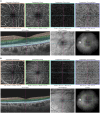Applications of optical coherence tomography angiography in glaucoma: current status and future directions
- PMID: 39364027
- PMCID: PMC11446750
- DOI: 10.3389/fmed.2024.1428850
Applications of optical coherence tomography angiography in glaucoma: current status and future directions
Abstract
Glaucoma is a leading cause of irreversible blindness worldwide, with its pathophysiology remaining inadequately understood. Among the various proposed theories, the vascular theory, suggesting a crucial role of retinal vasculature deterioration in glaucoma onset and progression, has gained significant attention. Traditional imaging techniques, such as fundus fluorescein angiography, are limited by their invasive nature, time consumption, and qualitative output, which restrict their efficacy in detailed retinal vessel examination. Optical coherence tomography angiography (OCTA) emerges as a revolutionary imaging modality, offering non-invasive, detailed visualization of the retinal and optic nerve head microvasculature, thereby marking a significant advancement in glaucoma diagnostics and management. Since its introduction, OCTA has been extensively utilized for retinal vasculature imaging, underscoring its potential to enhance our understanding of glaucoma's pathophysiology, improving diagnosis, and monitoring disease progression. This review aims to summarize the current knowledge regarding the role of OCTA in glaucoma, particularly its potential applications in diagnosing, monitoring, and understanding the pathophysiology of the disease. Parameters pertinent to glaucoma will be elucidated to illustrate the utility of OCTA as a tool to guide glaucoma management.
Keywords: glaucoma; glaucoma progression detection; optical coherence tomography angiography; retinal imaging; vessel density.
Copyright © 2024 Shen, Chan, Yip and Chan.
Conflict of interest statement
The authors declare that the research was conducted in the absence of any commercial or financial relationships that could be construed as a potential conflict of interest.
Figures




Similar articles
-
Optical Coherence Tomography Angiography in Glaucoma Care.Curr Eye Res. 2018 Sep;43(9):1067-1082. doi: 10.1080/02713683.2018.1475013. Epub 2018 May 23. Curr Eye Res. 2018. PMID: 29757019 Review.
-
Optical Coherence Tomography and Optical Coherence Tomography Angiography: Essential Tools for Detecting Glaucoma and Disease Progression.Front Ophthalmol (Lausanne). 2023;3:1217125. doi: 10.3389/fopht.2023.1217125. Epub 2023 Jul 28. Front Ophthalmol (Lausanne). 2023. PMID: 37982032 Free PMC article.
-
The Role of Optical Coherence Tomography Angiography in Glaucoma.Semin Ophthalmol. 2024 Aug;39(6):412-423. doi: 10.1080/08820538.2024.2343049. Epub 2024 Apr 20. Semin Ophthalmol. 2024. PMID: 38643350 Review.
-
Optical coherence tomography angiography: an overview of the technology and an assessment of applications for clinical research.Br J Ophthalmol. 2017 Jan;101(1):16-20. doi: 10.1136/bjophthalmol-2016-309389. Epub 2016 Oct 4. Br J Ophthalmol. 2017. PMID: 27707691 Review.
-
Potential applications of optical coherence tomography angiography in glaucoma.Curr Opin Ophthalmol. 2018 May;29(3):226-233. doi: 10.1097/ICU.0000000000000475. Curr Opin Ophthalmol. 2018. PMID: 29553952 Review.
References
-
- Sun Y, Chen A, Zou M, Zhang Y, Jin L, Li Y, et al. . Time trends, associations and prevalence of blindness and vision loss due to glaucoma: an analysis of observational data from the global burden of disease study 2017. BMJ Open. (2022) 12:e053805. doi: 10.1136/bmjopen-2021-053805, PMID: - DOI - PMC - PubMed
-
- Distelhorst JS, Hughes GM. Open-angle glaucoma. Am Fam Physician. (2003) 67:1937–44. PMID: - PubMed
-
- Dietze J, Blair K, Havens SJ. Glaucoma. Treasure Island, FL: StatPearls Publishing; (2024). - PubMed
Publication types
LinkOut - more resources
Full Text Sources

